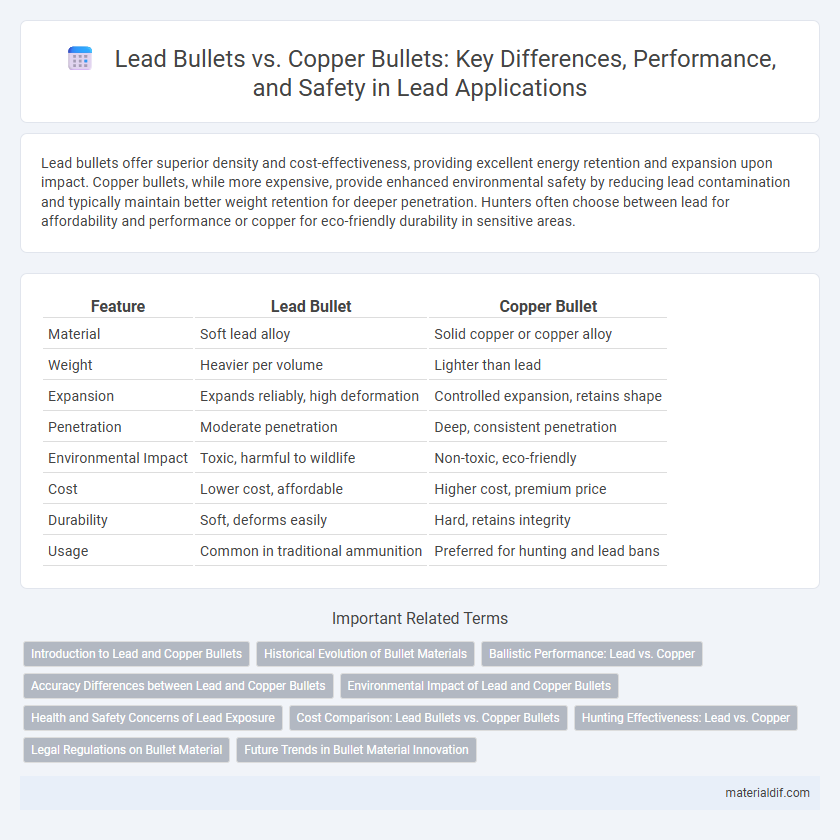Lead bullets offer superior density and cost-effectiveness, providing excellent energy retention and expansion upon impact. Copper bullets, while more expensive, provide enhanced environmental safety by reducing lead contamination and typically maintain better weight retention for deeper penetration. Hunters often choose between lead for affordability and performance or copper for eco-friendly durability in sensitive areas.
Table of Comparison
| Feature | Lead Bullet | Copper Bullet |
|---|---|---|
| Material | Soft lead alloy | Solid copper or copper alloy |
| Weight | Heavier per volume | Lighter than lead |
| Expansion | Expands reliably, high deformation | Controlled expansion, retains shape |
| Penetration | Moderate penetration | Deep, consistent penetration |
| Environmental Impact | Toxic, harmful to wildlife | Non-toxic, eco-friendly |
| Cost | Lower cost, affordable | Higher cost, premium price |
| Durability | Soft, deforms easily | Hard, retains integrity |
| Usage | Common in traditional ammunition | Preferred for hunting and lead bans |
Introduction to Lead and Copper Bullets
Lead bullets, historically favored for their high density and excellent malleability, offer superior energy transfer and penetration in shooting applications. Copper bullets, crafted from a non-toxic metal, provide enhanced environmental safety and reduced barrel fouling while maintaining consistent weight and performance. Advances in bullet technology have diversified the choice between traditional lead and modern copper options, catering to specific hunting, target shooting, and regulatory requirements.
Historical Evolution of Bullet Materials
Lead bullets dominated firearm ammunition from the 19th century due to their density and malleability, enabling effective stopping power and ease of manufacturing. The transition to copper bullets began in the late 20th century, driven by environmental concerns and advances in metallurgy that allowed for improved ballistic performance and reduced lead toxicity. Modern copper bullet designs emphasize controlled expansion and weight retention, marking a significant evolution from traditional lead projectiles.
Ballistic Performance: Lead vs. Copper
Lead bullets generally offer superior ballistic performance due to their higher density, which allows for better energy retention and deeper penetration on impact. Copper bullets, while less dense, provide improved weight retention and consistent expansion, enhancing accuracy and terminal performance. The ballistic coefficient of lead bullets tends to be higher, resulting in flatter trajectories and better downrange stability compared to copper alternatives.
Accuracy Differences between Lead and Copper Bullets
Lead bullets typically offer superior accuracy due to their malleability, allowing for better sealing in the barrel and reduced deformation upon firing. Copper bullets, while harder and less prone to fouling, can experience increased barrel wear and slightly lower accuracy because they do not conform as precisely to the rifling. Studies indicate that lead bullets often deliver tighter groupings and more consistent velocity variations compared to their copper counterparts.
Environmental Impact of Lead and Copper Bullets
Lead bullets pose significant environmental threats due to their toxicity, contaminating soil and water and accumulating in wildlife, which can lead to severe health problems and mortality in animals. Copper bullets, while less toxic, degrade more slowly and can still leave metal residues in ecosystems, but they are generally considered safer for wildlife and reduce the risk of lead poisoning. Choosing copper bullets over lead reduces the environmental impact by minimizing toxic exposure and promoting healthier ecosystems.
Health and Safety Concerns of Lead Exposure
Lead bullets pose significant health and safety risks due to lead contamination from residue and fragments, which can cause lead poisoning in humans and wildlife through inhalation or ingestion. Copper bullets offer a safer alternative by eliminating lead exposure, reducing environmental toxicity, and preventing neurological damage linked to lead accumulation. Choosing copper bullets minimizes long-term health hazards and supports ecosystem sustainability by avoiding the persistent contamination associated with lead ammunition.
Cost Comparison: Lead Bullets vs. Copper Bullets
Lead bullets generally offer a lower cost per round compared to copper bullets, making them more budget-friendly for target practice and informal shooting. Copper bullets, while more expensive upfront, provide enhanced performance and environmental benefits that can justify their higher price for hunting and precision shooting. The cost difference is influenced by material prices, manufacturing complexity, and market demand, with lead remaining the economical choice for high-volume shooting.
Hunting Effectiveness: Lead vs. Copper
Lead bullets deliver higher density and expansion upon impact, improving penetration and energy transfer for effective hunting. Copper bullets, while lighter, offer superior fragmentation and weight retention, reducing barrel fouling and enhancing accuracy. Hunters seeking deep penetration often prefer lead, whereas those prioritizing environmental safety and consistent shot placement opt for copper.
Legal Regulations on Bullet Material
Legal regulations on bullet materials vary significantly, with many jurisdictions restricting or banning lead bullets due to environmental and health concerns. Copper bullets are often preferred in areas where lead is prohibited, as they comply with non-toxic ammunition laws established to prevent wildlife contamination. Regulations also dictate specific use cases, such as hunting or shooting ranges, mandating copper or other non-lead alternatives to minimize toxic exposure and soil pollution.
Future Trends in Bullet Material Innovation
Future trends in bullet material innovation highlight a growing shift from traditional lead bullets to copper alternatives due to environmental and health concerns. Copper bullets offer superior ballistic performance and are favored for their non-toxic properties, aligning with increasing regulatory restrictions on lead ammunition. Advances in metallurgy and manufacturing processes are expected to further enhance copper bullet effectiveness, driving widespread adoption in hunting, law enforcement, and military applications.
Lead bullet vs Copper bullet Infographic

 materialdif.com
materialdif.com